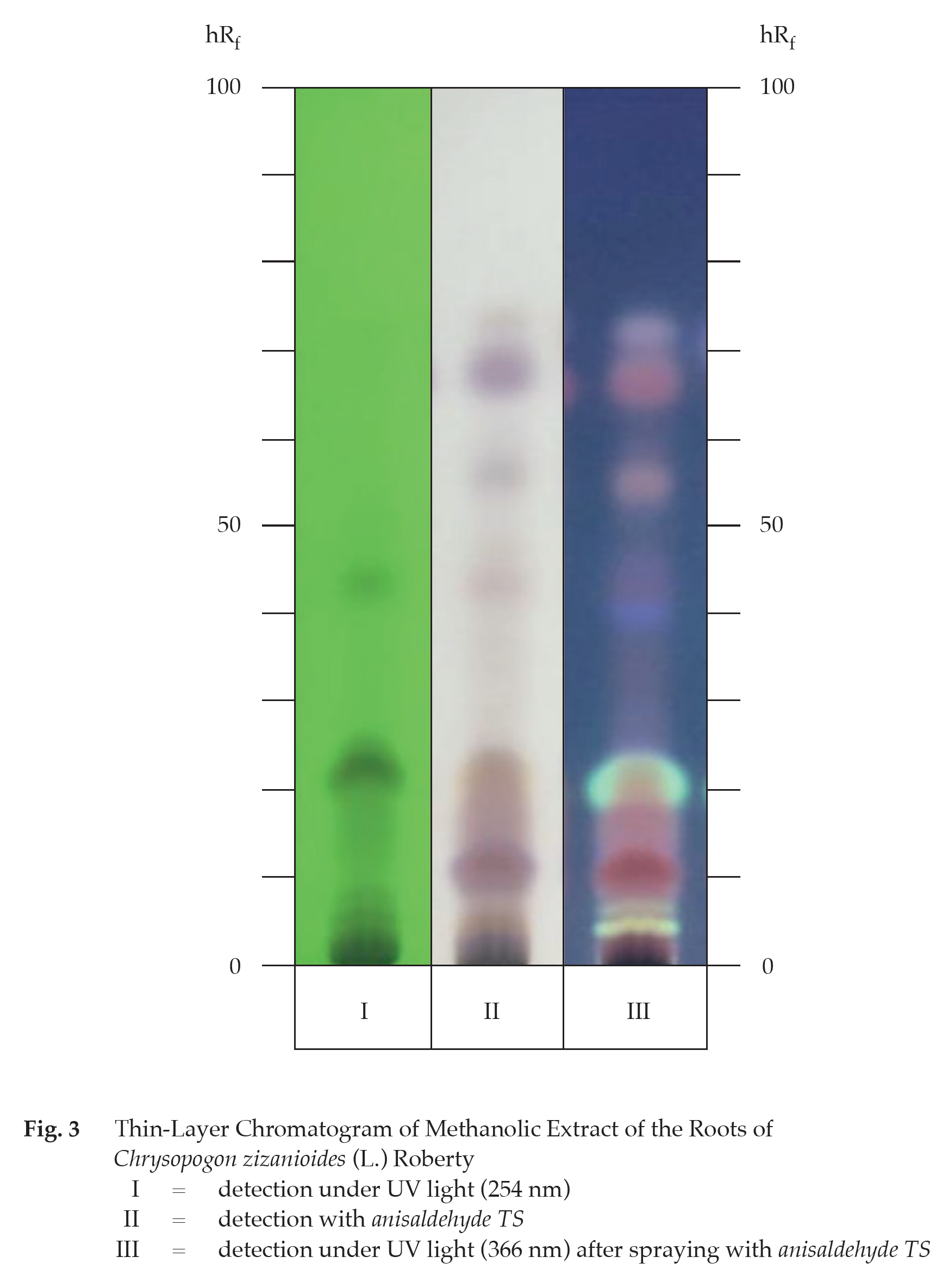ตำรามาตรฐานยาสมุนไพรไทย
Thai Herbal Pharmacopoeia
สำนักยาและวัตถุเสพติด กรมวิทยาศาสตร์การแพทย์ กระทรวงสาธารณสุข
Bureau of Drug and Narcotic, Department of Medical Sciences, Ministry of Public Health(Tinospora crispa (L.) Hook.f. & Thomson)
(Nelumbo nucifera Gaertn.)
(Centella asiatica (L.) Urb.)
(Centella Dry Extract)
(Centella Cream)
(Mesua ferrea L.)
(Piper sarmentosum Roxb.)
(Piper sarmentosum Roxb.)
(Pterocarpus santalinus L. f.)
(Santalum album L.)
(Senna tora (L.) Roxb.)
(Senna alata (L.) Roxb.)
(Senna Alata Tea)
(Piper retrofractum Vahl)
(Myristica fragrans Houtt)
(Andrographis paniculata (Burm. f.) Nees)
(Andrographis Capsules)
(Allium ascalonicum L.)
(Ocimum tenuiflorum L.)
(Curcuma longa L.)
(Turmeric Capsules)
(Turmeric Dry Extract)
(Turmeric Dry Extract Capsules)
(Arcangelisia flava (L.) Merr.)
(Curcuma sp.)
Harrisonia perforata (Blanco) Merr.
(Aristolochia pierrei Lecomte)
(Zingiber officinale Roscoe)
(Ginger Capsules)
(Ginger Tea)
(Cassia fistula L.)
(Nardostachys jatamansi (D. Don) DC.)
(Angelica sinensis (Oliv.) Diels)
Artemisia annua L.
(Ligusticum sinense Oliv. cv. Chuanxiong)
(Neopicrorhiza scrophulariiflora Pennell)
(Atractylodes lancea (Thunb.) DC.)
(Aucklandia lappa Decne)
(Terminalia chebula Retz.)
(Angelica dahurica (Hoffm.) Benth. & Hook. f. ex Franch. & Sav. var. dahurica)
(Kaempferia parviflora Wall. ex Baker)
(Hibiscus sabdariffa L.)
(Roselle Tea)
(Allium sativum L.)
(Zingiber zerumbet (L.) Sm.)
(Wurfbainia testacea (Ridl.) Škorničk.& A. D. Poulsen)
(Cannabis sativa L.)
(Myristica fragrans Houtt)
(Dracaena cochinchinensis (Lour.) S. C. Chen)
(Ficus racemosa L.)
(Hyptis suaveolens (L.) Poit.)
Clerodendrum indicum (L.) Kuntze
(Phyllanthus emblica L.)
(Citrus hystrix DC.)
(Citrus hystrix DC.)
(Areca catechu L.)
(Momordica charantia L.)
Moringa oleifera Lam.
(Aegle marmelos (L.) Corrêa)
(Solanum trilobatum L.)
(Morus alba L.)
Gynostemma pentaphyllum(Thunb.)
Makino
(Clinacanthus nutans (Burm. f.) Lindau)
(Cissus quadrangularis L.)
(Mimusops elengi L.)
(Zingiber montanum (J. König) Link. ex A. Dietr.)
(Piper betle L.)
(Capsicum annuum L.)
(Capsicum Oleoresin)
(Capsicum Gel)
(Piper nigrum L.)
(Piper nigrum L.)
(Eurycoma longifolia Jack)
(Thunbergia laurifolia Lindl.)
(Piper wallichii (Miq.) Hand.-Mazz.)
Senna garrettiana (Craib) H. S. Irwin & Barneby
(Terminalia bellirica (Gaertn.) Roxb.)
(Terminalia chebula Retz.)
(Caesalpinia bonduc (L.) H. Roxb.)
(Tarlmounia elliptica (DC.) H. Rob., S. C. Keeley, Skvaria & R. Chan)
(Hog Creeper Vine Dry Extract Capsiles)
(Hog Creeper Vine Dry Extract)
(Brachypterum scandens (Roxb.) Miq.)
(Lepidium sativum L.)
(Nigella sativa L.)
(Cuminum cyminum L.)
(Foeniculum vulgare Mill.)
(Plantago ovata Forssk.)
(Pimpinella anisum L.)
(Carum carvi L.)
(Anethum graveolens L.)
(Trachyspermum ammi (L.) Sprague)
Albizia procera (Roxb.) Benth.
(Acorus calamus L.)
(Tiliacora triandra (Colebr.) Diels)
Cyanthillium cinereum (L.) H. Rob.
(Orthosiphon aristatus (Blume) Miq.)
Murdannia loriformis (Hassk.) R. S. Rao & Kammathy
(Capparis micracantha DC.)
(Chrysopogon zizanioides (L.) Roberty)
(Cyperus rotundus L.)
(Cannabis sativa L.)
(Syzygium aromaticum (L.) Merr. & L. M. Perry)
(Boesenbergia rotunda (L.) Mansf.)
(Acanthus ebracteatus Vahl)
(Acanthus ilicifolius L.)
(Kaempferia galanga L.)
(Curcuma comosa Roxb.)
Betula alnoides Buch.-Ham. ex D. Don
Cannabis sativa L.
Carthamus tinctorius L
Mitragyna speciosa (Korth.) Havil
Mallotus repandus (Rottler) Müll. Arg
Azadirachta indica A. Juss. var. siamensis Valeton
Azadirachta indica A. Juss. var. siamensis Valeton
Punica granatum L.
Rhinacanthus nasutus (L.) Kurz
Baliospermum solanifolium (Burm.) Suresh
Curcuma aeruginosa Roxb
Boesenbergia kingii Mood & L. M. Prince
Senegalia rugata (Lam.) Britton & Rose
Acacia concinna (Willd.) DC.
Senegalia rugata (Lam.) Britton & Rose
Acacia concinna (Willd.) DC.
Senna alexandriana Mill. var. alexandriana
Cassia acutifolia Delile, Cassia angustifolia Vahl
Butea superba Roxb. ex Willd.
[Plaso superba (Roxb. ex Willd.) Kuntze, Rudolphia superba (Roxb. ex Willd.) Poir.
Pueraria candollei Graham
ex Benth. var. mirifica (Airy Shaw & Suvat.) Niyomdham
Streblus asper Lour.
Suregada multiflora (A. Juss.) Baill. (Gelonium
multiflorum A. Juss.
Vetiver Root is the dried root of Chrysopogon zizanioides (L.) Roberty [Andropogon muricatus Retz., A. zizanioides (L.) Urb., Phalaris zizanioides L., Vetiveria zizanoides (L.) Nash ex Small] (Family Gramineae), Herbarium Specimen Number: BKF 200904, DMSC 5305, Crude Drug Number: DMSc 1200.
Constituents Vetiver Root contains a volatile oil, of which khusimol, khusimone, α-and β-vetivone are its major components.
Description of the plant (Figs. 1a, 1b) Perennial herb, tufted; culm stout, up to 2.5 m tall, about 5 mm in diameter; root stout, aromatic. Leaves simple, stiff, linear to oblong, 30 to 90 cm long, 0.5 to 1 cm wide, apex acute, base obtuse, margin scabrous, upper surface pale green, pilose towards base, lower surface glabrous; leaf sheaths glabrous, lower ones sharply keeled and imbricate in fanlike clusters; ligule about 0.5 mm long, margin scarious, upper margin ciliate. Inflorescence paniculate, large, erect, 13 to 30 cm long, central axis with whorls of racemes, 5 to 7.5 cm long, purplish, silver, or greyish. Spikelets in pairs, one pedicelled, one sessile, with 5 to 13 pairs; lower spikelet sessile, fertile, glabrous; glumes with minute spines on outer surface; lower glume 3-nerved, upper glume 1-nerved; lower floret with lemma only, upper floret with membranous lemma and palea; lodicules 2, truncate; pedicelled spikelet sterile, lower glume with minute spines on outer surface; stamens 3, anther orange, linear, about 2 mm long; ovary with 2 feather-like styles, purple. Fruit a caryopsis, 4 to 5 mm long, with short spine. Seed oblong.
Description Odour, strongly aromatic, sandal wood-like; taste, bitter.
Macroscopical (Figs. 1a, 1b) Clusters of wiry roots, minute, 0.5 to 1.5 mm in diameter, longitudinally grooved, varied in colour from cream, grey or light yellow to brown; fracture, short and splintery.
Microscopical (Figs. 2a, 2b, 2c) Transverse section of the root shows epidermis, cortex, vascular tissue, and pith. Epidermis: a layer of polygonal cells, with unicellular root hairs. Cortex: lamellar collenchyma, 1 to 4 layers of fibres, polygonal parenchyma, some containing starch grains and/or crystals, aerenchyma, large air spaces, oil cells, and a layer of endodermis. Vascular tissue: polyarch bundles, a layer of pericycle, with some modified lateral roots primordial, xylem and phloem. Pith: polygonal parenchyma, some containing starch grains, crystals or oil droplets and horseshoe-shaped cells.
Vetiver Root in powder possesses the diagnostic microscopical characters of the unground drug. Reticulate-pitted and bordered-pitted vessels are frequently observed; simple and compound starch grains are also observed.
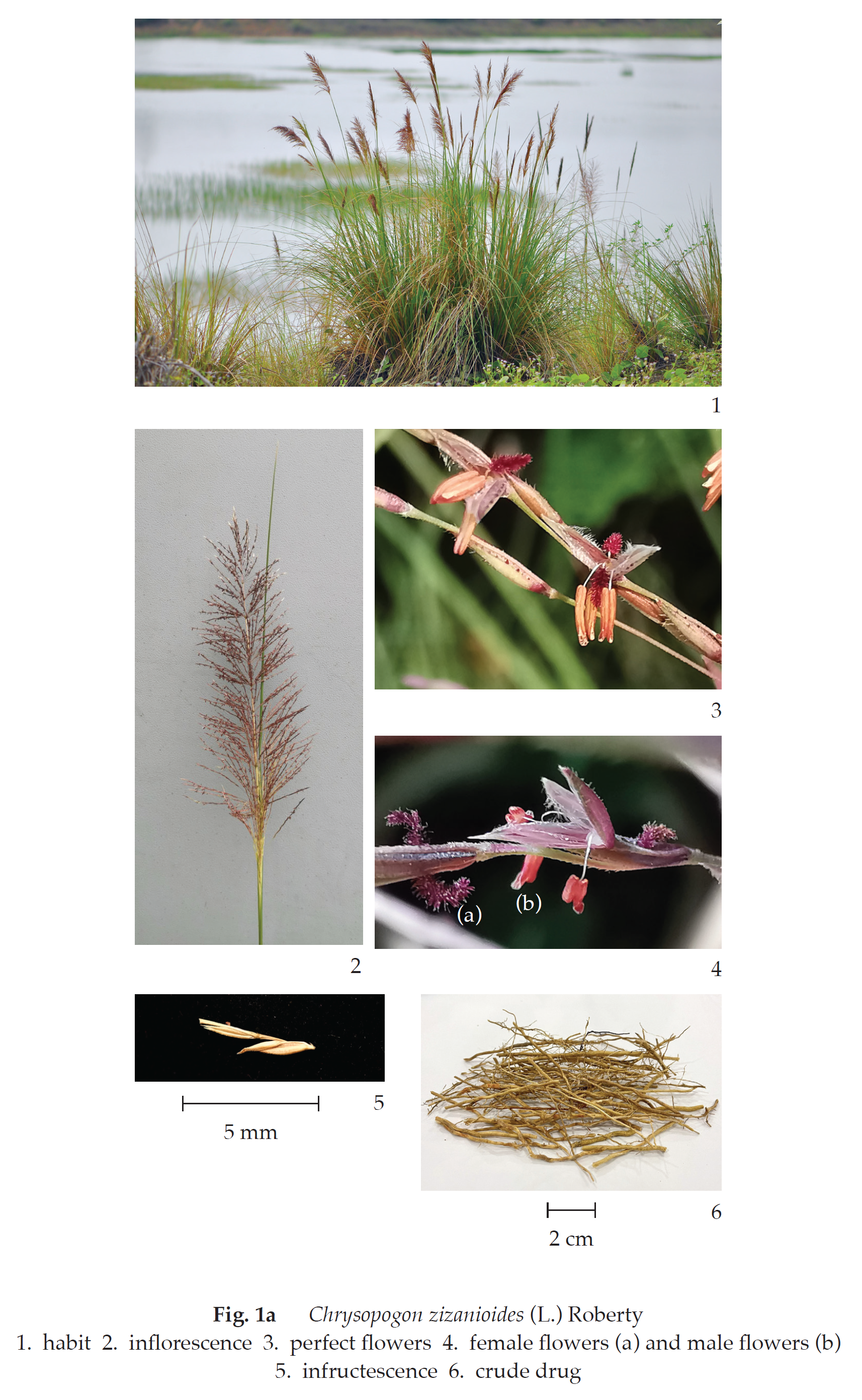
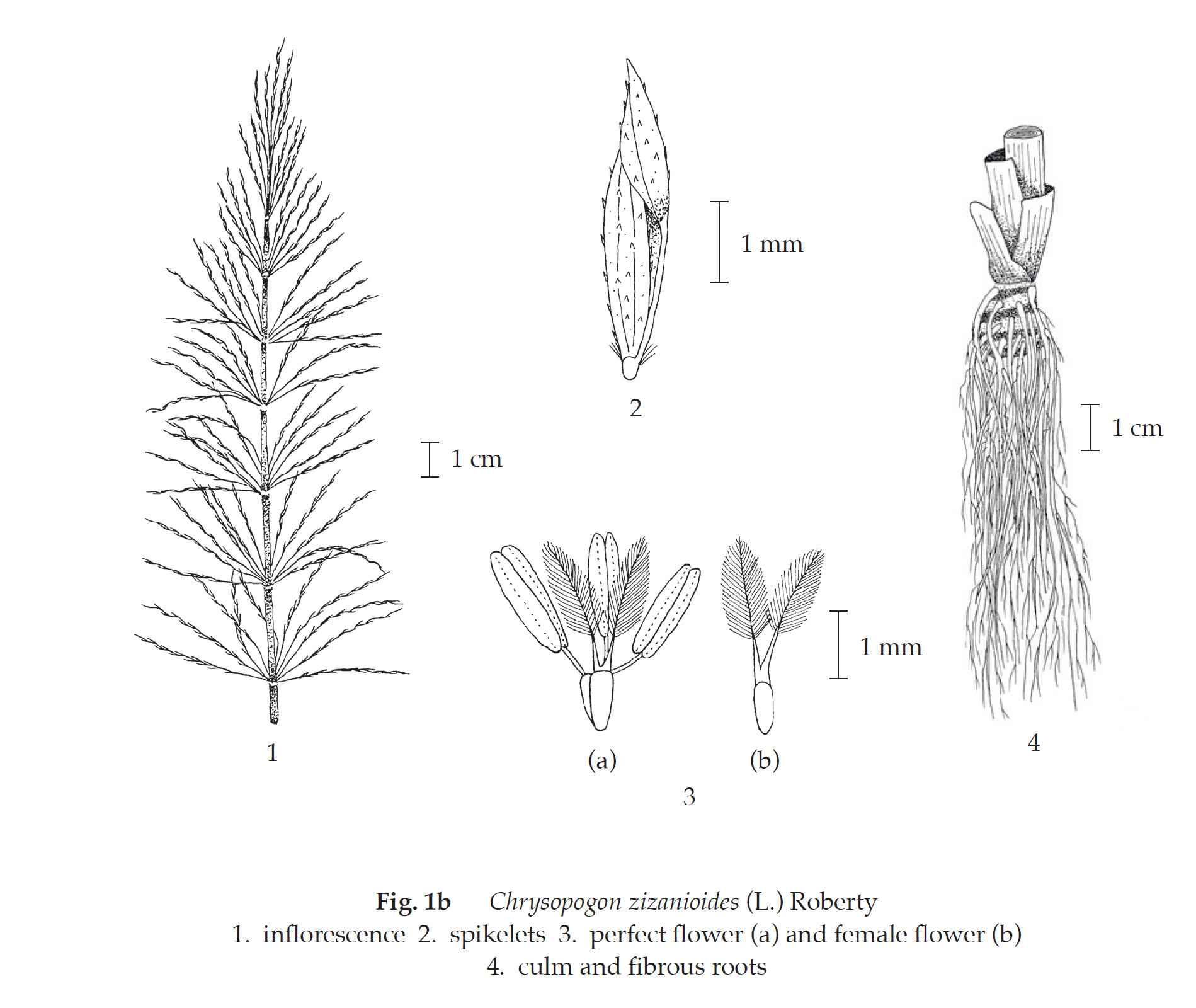
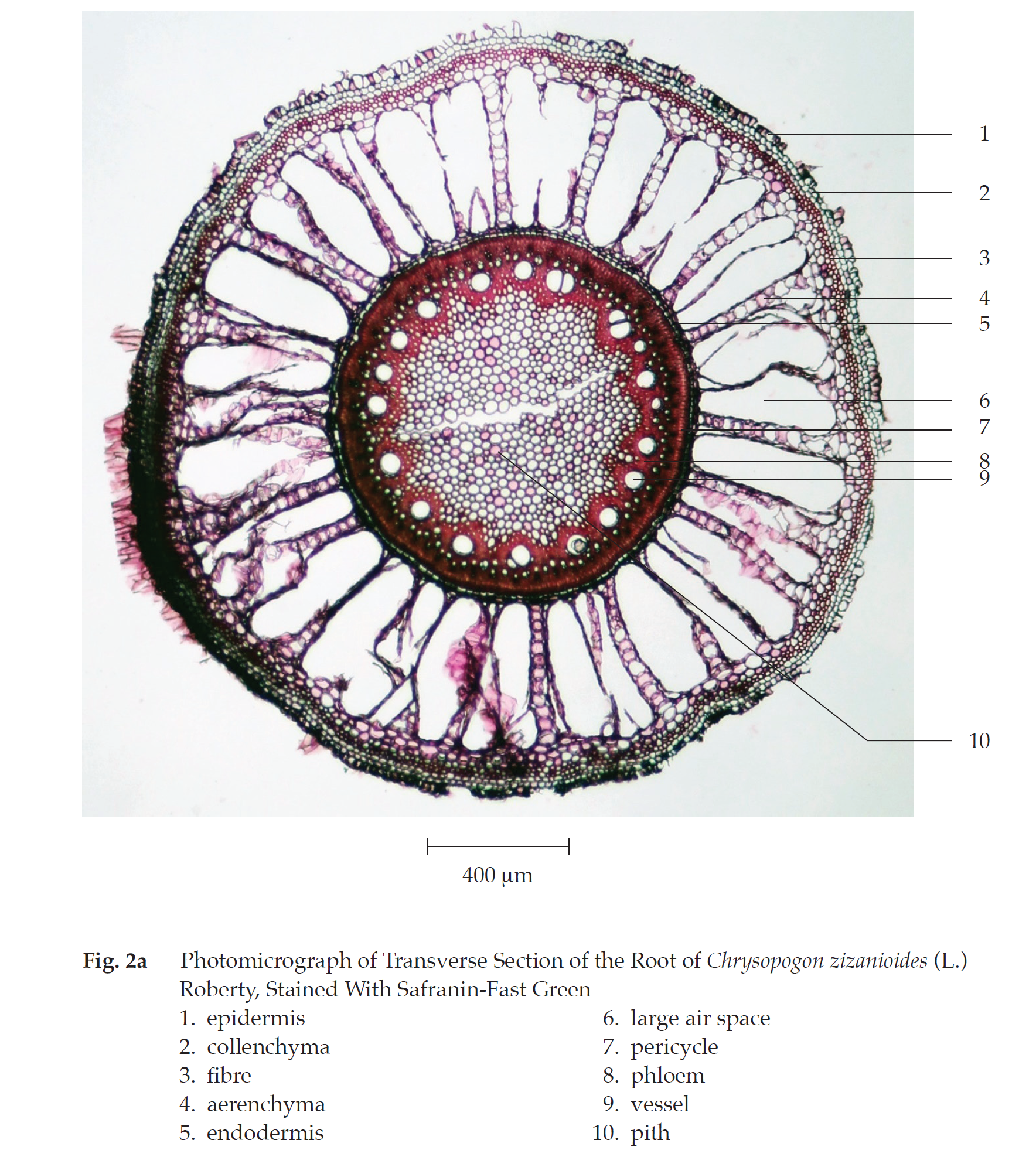
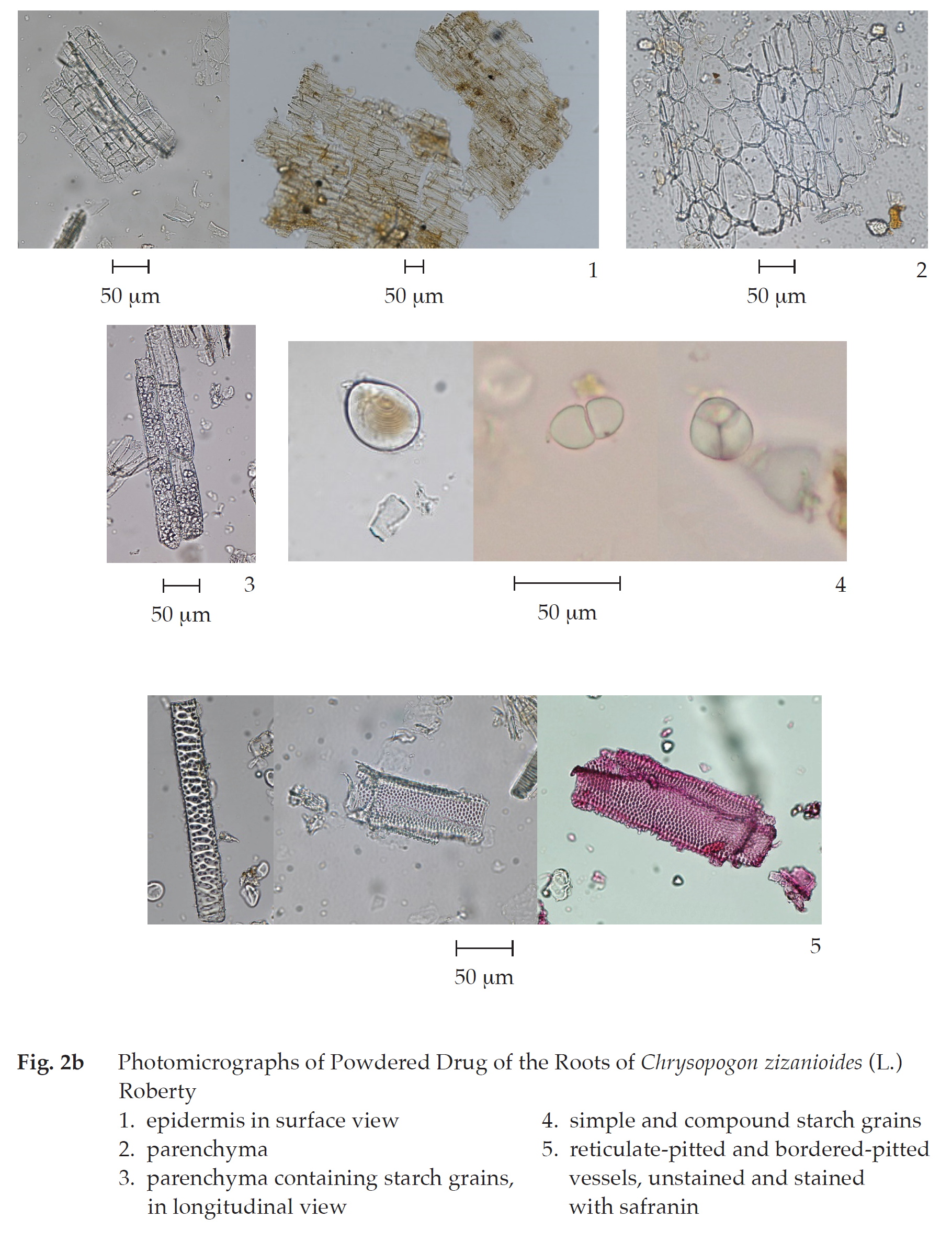
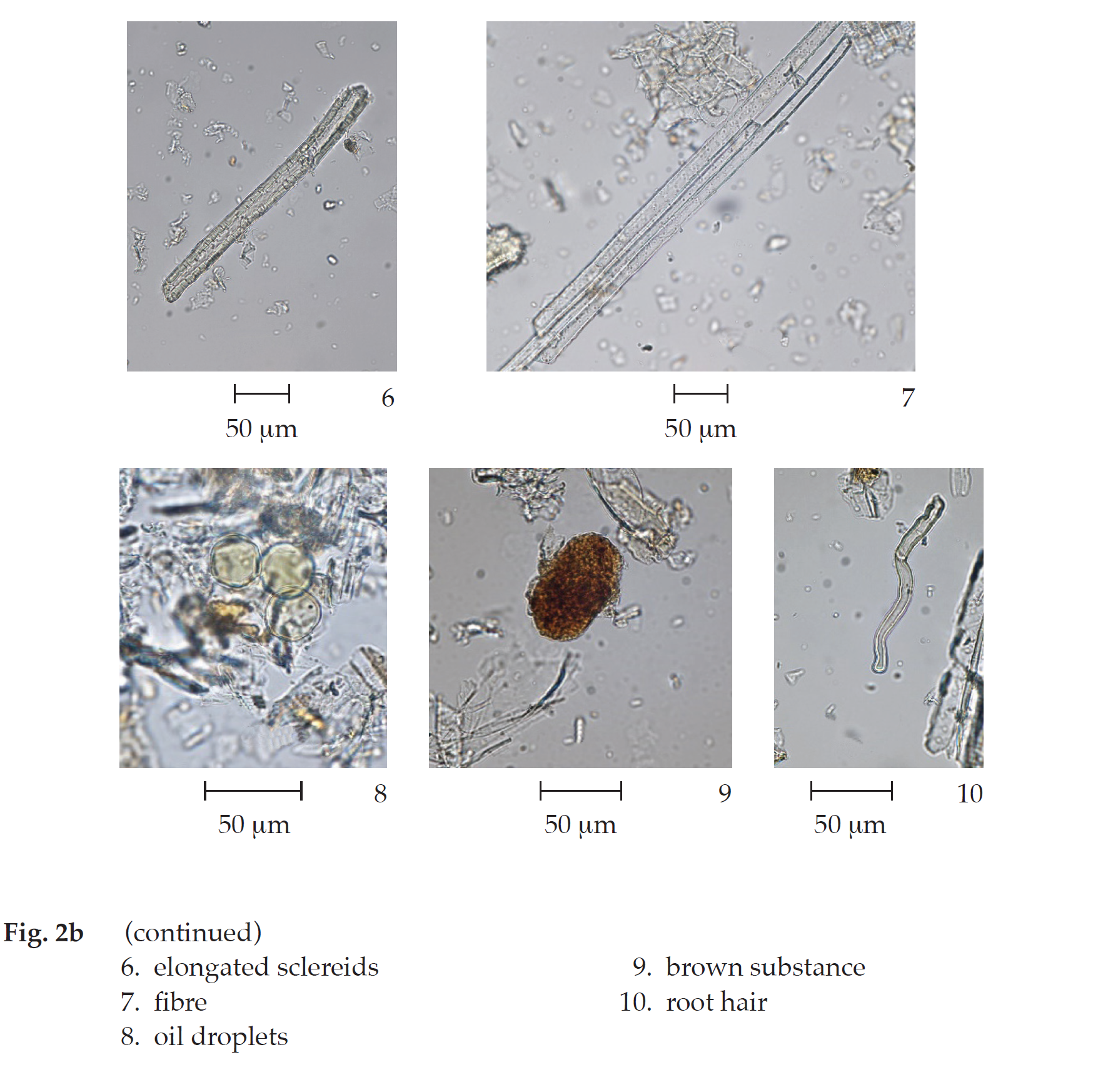
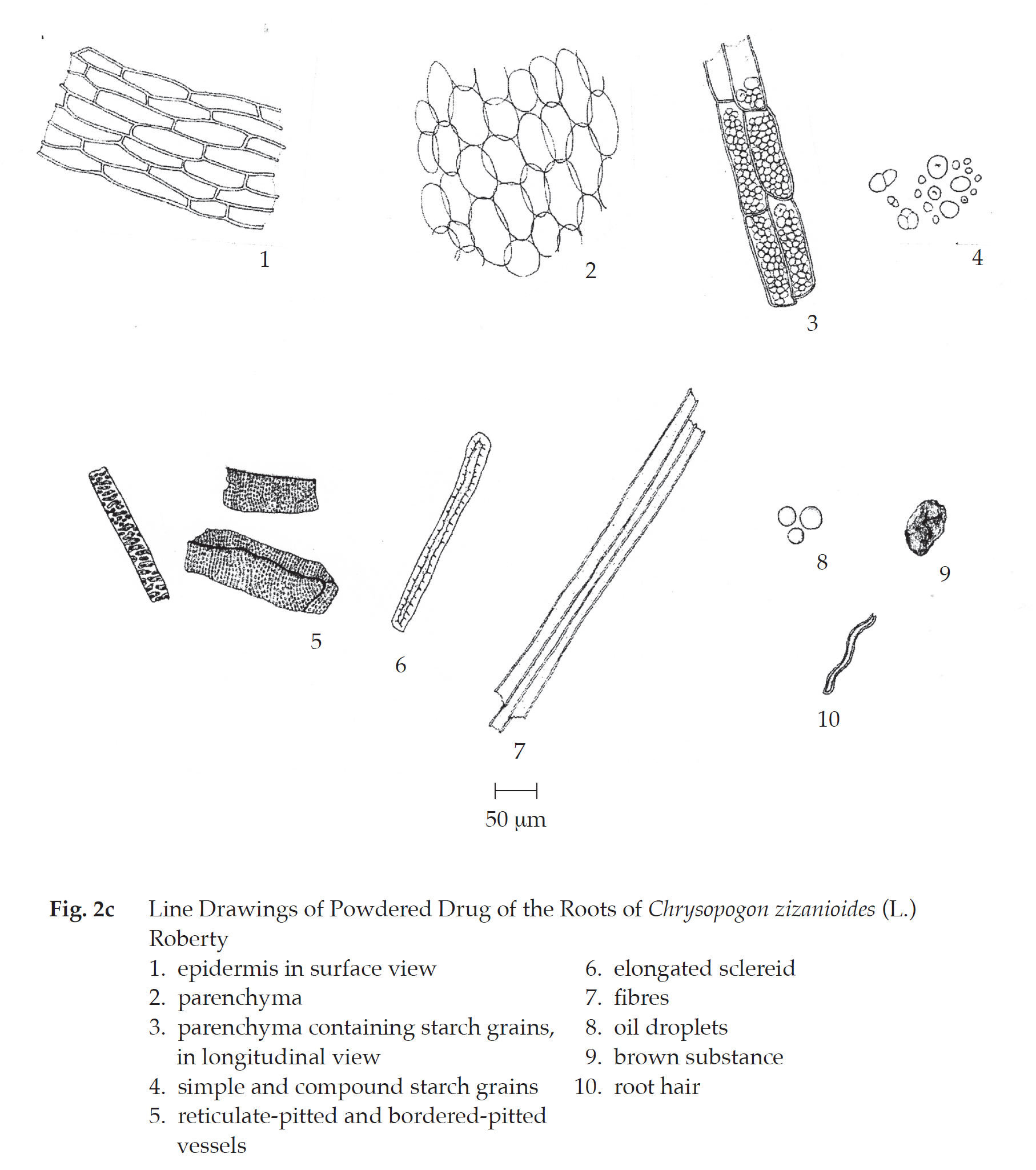
Packaging and storage Vetiver Root shall be kept in well-closed containers, preferably of metal or glass, protected from light and stored in a cool and dry place.
Identification
A. Sonicate 1 g of the sample, in powder, with 10 mL of methanol for 30 minutes and filter (solution 1). To 2 mL of solution 1, add a few drops of ninhydrin TS and heat on a water-bath: a violet colour is produced.
B. To 2 mL of solution 1, add 2 or 3 pieces of magnesium ribbon, shake well and mix with a few drops of hydrochloric acid: a pinkish orange colour develops.
C. Carry out the test as described in the “Thin-Layer Chromatography” (Appendix 3.1), using silica gel 60 F254 as the coating substance and a mixture of 76 volumes of n-hexane, 4 volumes of ethanol and 2 volumes of glacial acetic acid as the mobile phase. Apply to the plate as a band of 8 mm, 15 μL of the test solution prepared by sonicating 1 g of the sample, in powder, with 10 mL of methanol for 30 minutes and filtering. Evaporate the filtrate to dryness under reduced pressure at 50°. Dissolve the residue in 1 mL of methanol. After removal of the plate, allow it to dry in air and examine the plate under ultraviolet light (254 nm), marking the quenching bands. Subsequently spray the plate with anisaldehyde TS and heat at 110° for 10 minutes. Two brown and five purple bands are observed. Examine the plate under ultraviolet light (366 nm); one blue, one green, one red, one yellow, and four purple fluorescent bands are observed (Fig. 3.)
Water Not more than 7.0 per cent v/w (Azeotropic Distillation Method, Appendix 4.12).
Foreign matter Not more than 2.0 per cent w/w (Appendix 7.2).
Acid-insoluble ash Not more than 8.0 per cent w/w (Appendix 7.6).
Total ash Not more than 11.0 per cent w/w (Appendix 7.7).
Ethanol-soluble extractive Not less than 2.0 per cent w/w (Appendix 7.12).
Water-soluble extractive Not less than 5.0 per cent w/w (Appendix 7.12).
Volatile oil Not less than 0.5 per cent v/w, calculated on the anhydrous basis (Appendix 7.3H). Use 30 g, in coarse powder, freshly prepared and accurately weighed. Use 500 mL of water as the distillation liquid and a 1000-mL round-bottomed flask. Distil at a rate of 2 to 3 mL per minute for 3 hours. Use 2.0 mL of xylene in the graduated tube.
